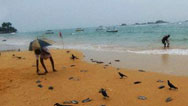Anatomy of a Tsunami
- By Susan K. Lewis
- Posted 03.29.05
- NOVA
In the days following the disastrous events of December 26, 2004, tsunami researchers produced remarkably accurate computer simulations of the monstrous series of waves that took hundreds of thousands of lives. Here, examine some of these models and other graphics that reveal details of the tsunami from its initial generation in deep water to its deadly collision with coasts around the Indian Ocean.
 Launch Interactive
Launch Interactive
See how the tsunami of 2004 developed, from its birth at the seafloor to its impact on coasts around the Indian Ocean.
This feature originally appeared on the site for the NOVA program Wave That Shook the World.
Credits
Special Thanks
- Eric Geist, U.S. Geological Survey
- Jana Goldman, NOAA
- Vasily Titov, Tsunami Program, NOAA/PMEL
- (Indian Ocean map)
- © GlobeXplorer
- (tsunami wavelength illustrations)
- © WGBH/NOVA, adapted from graphics by Vasily Titov, NOAA/PMEL
- (tsunami epicenter, wave at shoreline, wave in open ocean)
- Created by Miho Aoki at the Arctic Region Supercomputing Center, Scientific Consultant Elena Suleimani, Geophysical Institute, University of Alaska Fairbanks, provided courtesy of the NOAA and Alaska Sea Grant College Program
- (3-D wave propagation)
- Courtesy of Eric Geist, USGS
Images
Animations
Related Links
-

Japan's Killer Quake
An eyewitness account and investigation of the epic earthquake, tsunami, and nuclear crisis
-

Wave of the Future
What will it take to be ready for the next major tsunami?
-

Once and Future Tsunamis
With our world map, explore eight of the deadliest tsunamis of the past and see where the next big one could strike.
-

Wave That Shook the World
Experts reconstruct the 2004 Indian Ocean tsunami in an effort to prepare for the next big one.
You need the Flash Player plug-in to view this content.

